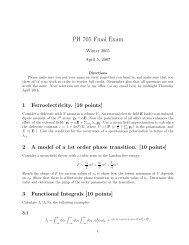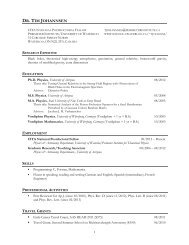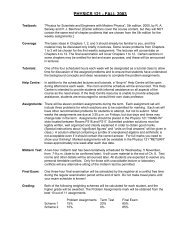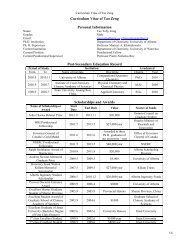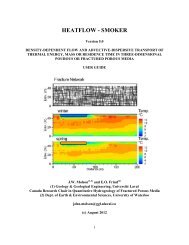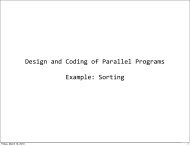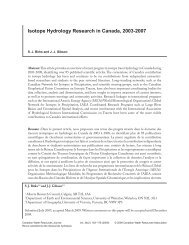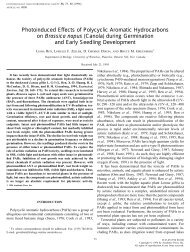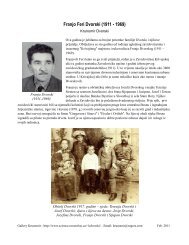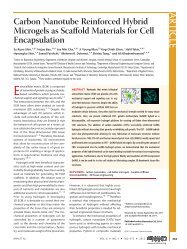POLYMIN - University of Waterloo
POLYMIN - University of Waterloo
POLYMIN - University of Waterloo
Create successful ePaper yourself
Turn your PDF publications into a flip-book with our unique Google optimized e-Paper software.
<strong>POLYMIN</strong> 2005<br />
where S k is the solid phase concentration <strong>of</strong> the k th solid component, [ML -3 ], and R k S represents<br />
the change in the k th solid component concentration [ML -3 T -1 ]. Further details are provided by<br />
Walter et al. (1994a).<br />
Oxygen Diffusion<br />
Assuming an immobile air phase (convection is neglected), oxygen transport through the<br />
unsaturated porous medium is governed by the 2D equation for oxygen diffusion, expressed as:<br />
θ<br />
eq<br />
2 2<br />
∂ [ O2 ]<br />
a<br />
⎛ ∂ [ O2 ]<br />
a ∂ [ O2<br />
]<br />
a<br />
⎞<br />
= D e ⎜ + - Q<br />
2 2 ⎟<br />
∂t ⎝ ∂ x ∂ z ⎠<br />
O 2<br />
(4)<br />
where θ eq (x,z,t) is the spatially and temporally-variable water phase corrected volumetric air<br />
content [-], D e (x,z,t) is the effective oxygen diffusion coefficient [L 2 T -1 ], and Q O2 (x,z,t) is the<br />
sink term for oxygen consumption due to sulphide mineral oxidation (M O2 /L 3 /T) (see below).<br />
The equivalent air content θ eq in Equation (4) is defined here as θ eq = θ a + Hθ w where θ a is the<br />
air-filled porosity and H is Henry’s Law coefficient for equilibrium oxygen partitioning between<br />
air and water (-). The oxygen diffusion coefficient D e is represented in <strong>POLYMIN</strong> by the Aachib<br />
et al. (2002) model:<br />
D<br />
e<br />
1 ⎡ p D<br />
a w pw<br />
= ⎢Daθ<br />
a<br />
+ θ<br />
w<br />
θ 2<br />
⎣ H<br />
s<br />
⎤<br />
⎥<br />
⎦<br />
(5)<br />
where D a and D w are the diffusion coefficients in air and water, respectively, and p a and p w are<br />
fitting coefficients; here p a = p w = 3.3 is assumed, as suggested by Aachib et al. (2002).<br />
The coefficient D e , representing diffusion within the air-filled porosity <strong>of</strong> the unsaturated spoil,<br />
can be represented using models presented by Elberling & Nicholson (1993), Millington &<br />
Quirk (1961), or Aachib et al. (2002).<br />
Sulphide Oxidation<br />
Acid mine drainage is controlled by the oxidation <strong>of</strong> sulphide minerals, mostly pyrite and<br />
pyrrhotite, within the waste rock. The oxidation <strong>of</strong> pyrite, for example, can be described in<br />
simplified form by the following stoichiometric equations (Wunderly et al, 1996):<br />
2+<br />
2- +<br />
Fe S 2 + H 2 O +7/2 O2<br />
⇒ Fe + 2 SO4<br />
+ 2 H<br />
9




